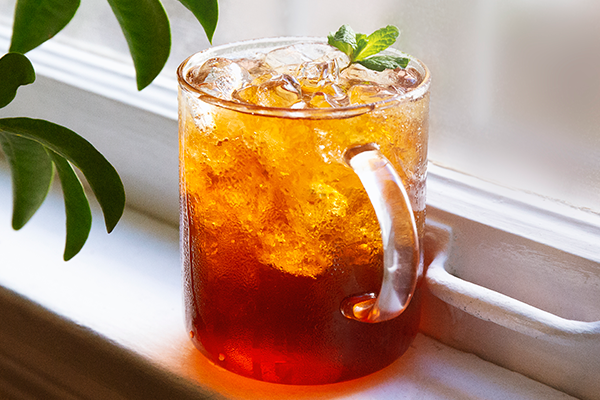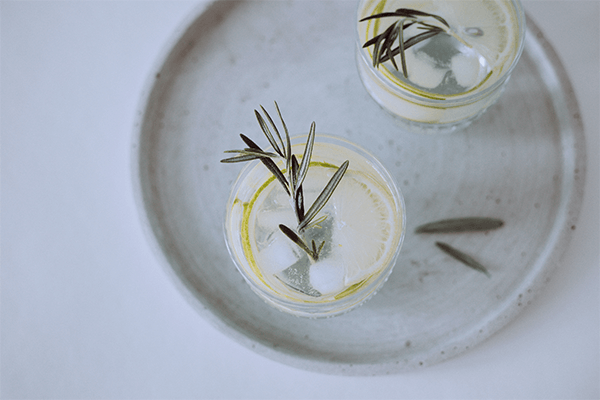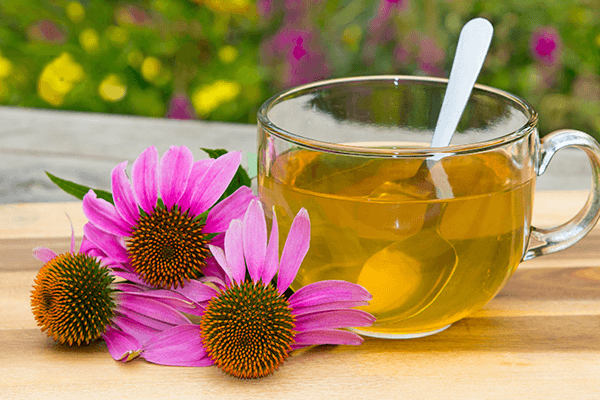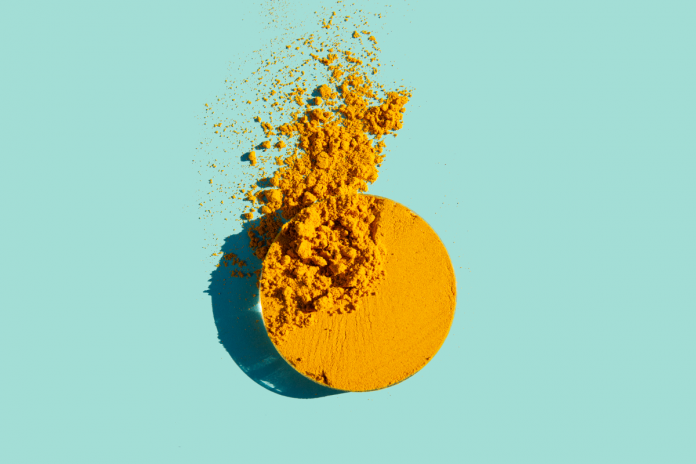Rooibos is a shrub-like plant native to South Africa that makes a smooth, delicious red tea.
In this article, you’ll learn the backstory of rooibos, how it’s made, its botanical characteristics, the healthy natural antioxidants it contains, and the delicious flavors of red and green rooibos.
Keep reading to discover everything you didn’t know about rooibos, starting with how to pronounce it.
What Is Rooibos Tea?
Rooibos (Aspalathus linearis), pronounced “ROY-boss” or “ROY-bows,” is a South African plant, the leaves of which make a red-colored, herbal tea or tisane.
The name rooibos means “red bush” in Afrikaans, and rooibos tea is also called African red tea, bush tea, or red bush tea. Unfortunately, the original indigenous name of rooibos is not widely known and may be lost.
Rooibos is a member of the Fabaceae or legume family, meaning it’s a relative of peas and beans. Although rooibos plants do form pod-like fruits with one or two seeds, only the needle-like leaves are used for tea-making.
Aspalathus linearis naturally grows wild in the fynbos ecoregion of South Africa, a biodiverse area that contains both coast and mountains and has a Mediterranean-type client with rainy winters.
Traditionally, indigenous peoples from the Khoisan or Khoesān group (which includes the Khoekhoe as well as Bushmen or San people) would climb hills or mountains to harvest leaves from wild rooibos plants.
But due to the growing popularity of rooibos tea around the world, the cultivation of domesticated rooibos for export and sale has overtaken wild harvesting. Cederberg, a city in Western Cape province, is famous for rooibos tea production.
The process for making red rooibos from Aspalathus is similar to making black tea from the Camellia sinensis plant. After harvest, the leaves undergo extensive oxidation or fermentation during an open-air aging process. (1)
While aging, the antioxidant glucoside aspalathin breaks down into other compounds, lending the leaves their characteristic reddish-brown color. (2)
Another style of rooibos, called green rooibos, undergoes less oxidation and contains higher levels of natural antioxidants. (1) The processing of green rooibos is analogous to making green tea, during which oxidation is halted by applying steam or heat to the recently-harvested leaves.
In addition to aspalathin, both types of rooibos tea contain quercetin, orientin, rutin, cinnamic acids, luteolin, and other polyphenolic antioxidants that have the potential to quench free radicals. (3)
The purported and studied health benefits of rooibos tea include anti-inflammatory effects as well as support for the immune system, healthy blood sugar levels, digestion, and cardiovascular function. (4)(5)(6)(7)
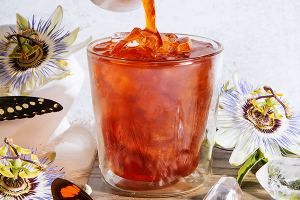
What does rooibos tea taste like?
Despite the intense red color of rooibos tea liquid, its flavors are gentle and smooth.
It’s mildly sweet, with some taste similarities to hibiscus tea. People describe rooibos as nutty yet slightly floral, and longer steeps can bring out full-bodied, rich, woody notes.
This herbal tea is low in tannins, meaning it’s not at all astringent or bitter and won’t upset your stomach. (8)
Our frothy rooibos date latte recipe uses dates as a natural sweetener to highlight the delightful, soft flavor profile of rooibos and is an excellent choice to hydrate or ease digestion any time of year.
In contrast, green rooibos tea lacks many of the nutty and rich notes of red rooibos tea. It’s still gentle, yet more comparable to a grassy, malty version of green tea.
Like red rooibos, green rooibos is naturally slightly sweet and without a hint of bitterness.
How much rooibos tea should I drink a day?
Similar to how regular consumption is necessary to realize the full health benefits of green tea, drinking rooibos tea daily is the best way to ensure you benefit from the polyphenols and other antioxidant compounds of rooibos.
However, according to a 2010 study, even a single serving of 13.5 ounces of rooibos tea supported favorable changes in nitric oxide levels and angiotensin-converting enzyme (ACE) in healthy volunteers. (9)
A 2011 study found that drinking six cups per day of fermented rooibos (red rooibos tea) for six weeks led to improvements in antioxidant markers and cholesterol levels in adults at risk of cardiovascular disease. (10)
There isn’t any evidence suggesting that a specific daily intake is optimal for everyone, but it’s a safe bet that greater amounts of rooibos tea lead to more pronounced health benefits.
Ultimately, the number of cups of rooibos tea you drink each day is entirely up to your personal preference.
And unlike caffeinated teas, rooibos tea is virtually impossible to over-consume.
Drinking too much of any liquid can cause physical problems including hyponatremia (dangerously low sodium levels) due to water intoxication, but as long as you limit your consumption to approximately 33 ounces (1000 ml) of rooibos tea at a time, hyponatremia is unlikely. (11)
Does rooibos tea make you sleepy?
Despite popular anecdotal claims that rooibos can treat insomnia, there’s currently no scientific or clinical evidence to that effect.
That said, there’s also no evidence that rooibos can’t help you get to sleep, and it’s widely considered one of the best teas for people who prefer to avoid caffeine.
Therefore, rooibos before bed could certainly help you relax, and there’s always the possibility that it has an undiscovered benefit for sleep quality or shortening sleep onset.
But plenty of people drink rooibos regularly as a morning or daytime beverage, so it’s unlikely to cause any unwanted drowsiness.
Speaking of rooibos tea side effects, there are essentially none.
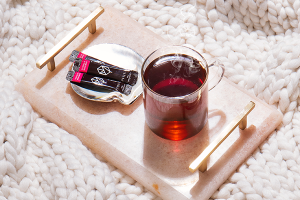
Rooibos Tea Side Effects
Some evidence suggests that certain compounds in Aspalathus linearis possess estrogenic activity, so people with estrogen receptor positive (ER+) cancers may want to steer clear or ask their physician before drinking rooibos. (12)
And although one case report from the European Journal of Clinical Pharmacology raised concerns that excessive long-term rooibos consumption may have led to liver damage in a patient, the authors ultimately concluded that rooibos has an “excellent safety record” and the case may have been due to product contamination. (13)
A separate animal study even found that rooibos tea may help protect the liver, meaning the likelihood of liver damage occurring is low. (14)
How to Prepare Rooibos Tea
The best way to enjoy rooibos is in loose leaf tea form. If possible, purchase high quality, organic rooibos whole leaf tea.
Like nearly every tea or tisane, rooibos is available in tea bags. However, tea bags don’t allow the needle-like rooibos leaves to circulate freely as they steep, and they may contain unwanted chemical additives.
Here’s how to brew rooibos tea at home:
- Bring water to a boil, then remove from heat
- Measure out 1 teaspoon (2-3 grams) of leaves per cup (8 ounces or 236 ml) of water and place into a heat-resistant vessel
- Pour the hot water onto your leaves and steep for 4-8 minutes
- Strain and serve
Remember that longer steeping times result in a richer, woodier flavor. You can experiment to discover your favorite length of steeping.
If you’re brewing green rooibos tea instead of red, try a temperature of 170-180 degrees Fahrenheit (76.5-82 degrees Celsius) instead of boiling water to preserve the more delicate flavor notes and antioxidants.
To make rooibos iced tea, brew it at double-strength (using half the water), strain into a pitcher and allow to cool to room temperature, then add lots of ice.
You can also cold brew rooibos for 24 hours or longer to make iced tea, but you may find you need to double or triple the amount of leaves you use, because steeping in cold water doesn’t result in as strong a brew.
Final Thoughts
Rooibos tea contains healthy, natural antioxidants not found in other herbal teas or true teas.
It also offers a unique flavor profile that’s delicious whether hot or iced, as well as in recipes with fruit or vanilla.
Whether you opt to use it as an occasional complement to other tisanes and Camellia sinensis teas or as a daily staple, rooibos merits a permanent place on your caffeine-free tea shelf.
